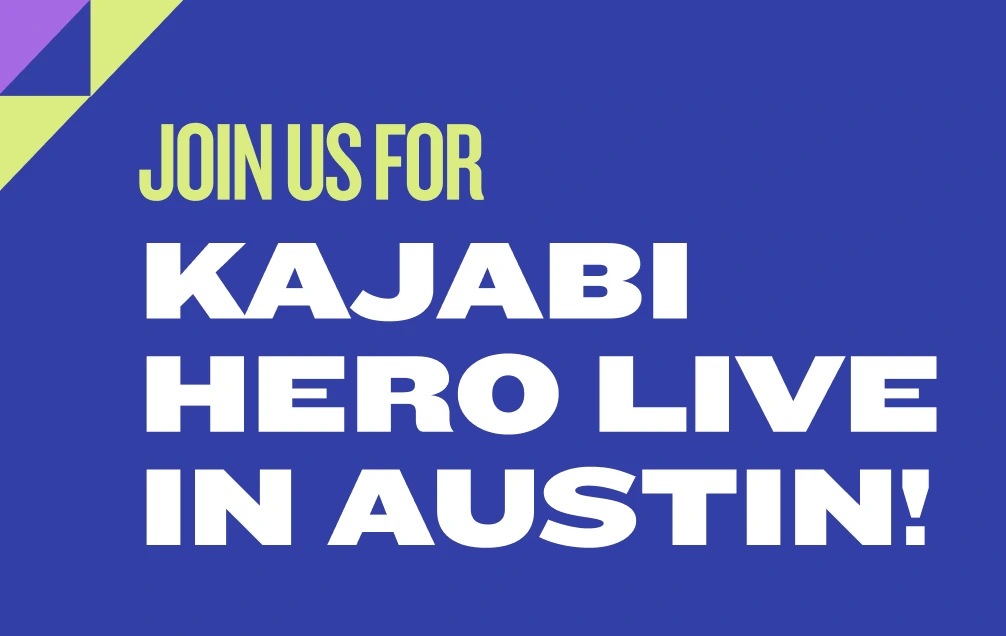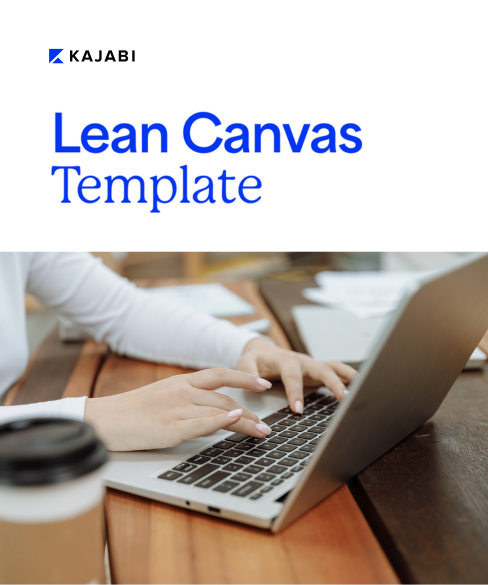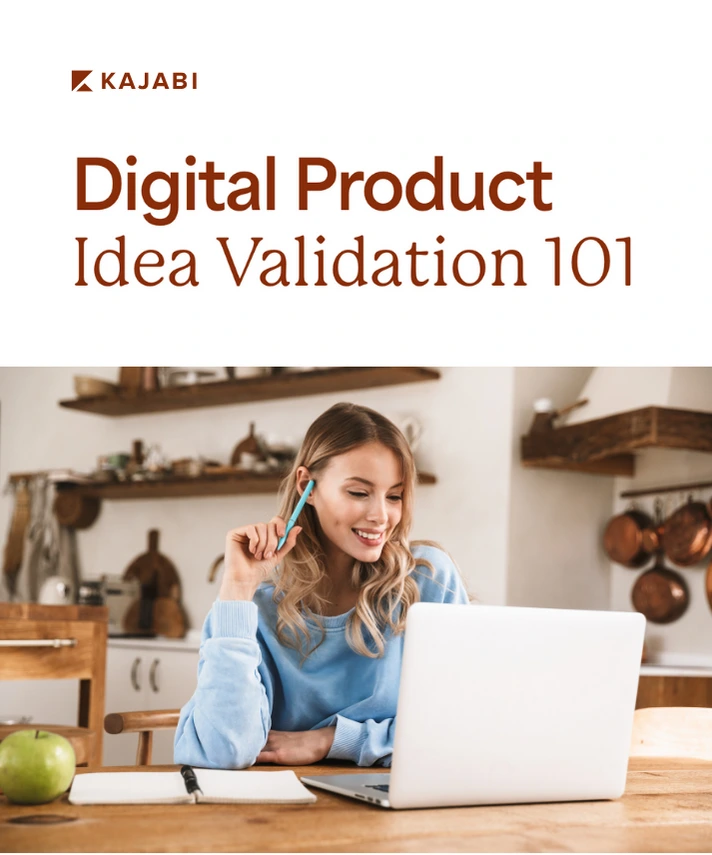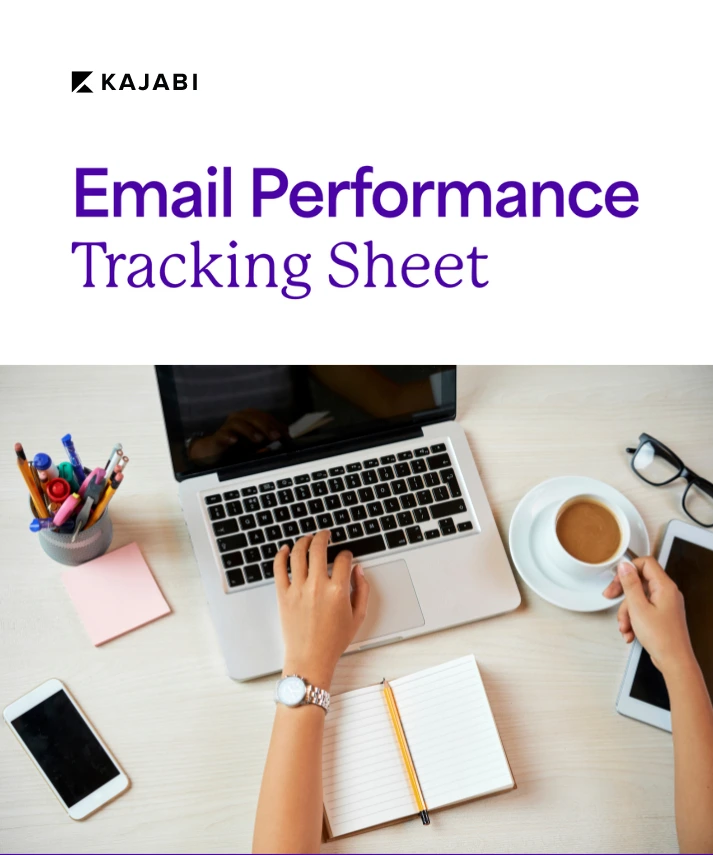
What is brand equity, why it's important, and examples
Get free expert insights and tips to grow your knowledge business sent right to your inbox.
When you sell a house, you depend on the equity in that property to buy a new one. Your total equity depends not only on the house’s value and sale price, but also on the amount of money you might still owe the bank.
Positive equity is always a good thing. It means that you’ve built up assets that you can later convert to cash if necessary.
“In business, brand equity works in a similar way. Although you can’t translate brand equity into cash as readily as you can equity in a home, it serves the same function. #Kajabi” — Tweet this!
Think about the last time that you visited the grocery store. You likely had lots of choices when it came to choosing a particular product.
You could have saved money by purchasing an off-brand product, but you might have chosen to purchase the original brand-specific product. You pay more for the brand product largely because of its brand equity.
For instance, most people know the product name Lucky Charms. Lucky Charms is a popular breakfast cereal that specifically appeals to kids.
Most supermarkets, however, also carry products that looks similar to Lucky Charms. They have different names, but they contain the same ingredients and often have a similar taste.
You buy Lucky Charms because you are familiar with the product and you know that millions of people trust it to keep their kids happy during breakfast in the morning.
In other words, Lucky Charms has more brand equity then off-brand version that costs less and might even taste the same. The reason lies in customer perception.
In Knowledge Commerce, you probably don't produce breakfast cereal. However, that doesn't mean that you should ignore brand equity and its potential ramifications for your company.
In fact, brand equity can play a major role in your company's future. The more brand equity you build, the easier it becomes to convince consumers to buy your online courses, subscribe to your membership site, and invest in your other digital products.
If you are not familiar with brand equity and its role in online business, we're here to help. We are going to break down the multiple facets of brand equity and help you leverage it for your Knowledge Commerce business.
What is Brand Equity?
Brand equity refers to the perceived value of a company or product based on its reputation among customers and consumers as well as its assets beyond mere revenue. It's just like Lucky Charms. General Mills can value its Lucky Charms brand at a higher price point than the amount of money generated by boxes sold.
This is because Lucky Charms has captured significant market share in the breakfast cereal niche and because it has a favorable reputation among consumers.
Let's translate that concept to Knowledge Commerce.
Consider a professional like Seth Godin. He's an extremely popular and successful marketer who has published numerous books and e-books on marketing and advertising.
He even makes some of his products available for free. This is in addition to his popular blog, which anyone can read and benefit from.
Anyone can write a blog and publish books about marketing. They might even make as much money as Seth Godin.
However, Seth Godin will have more brand equity than your average author or Knowledge Commerce professional because he has become a household name as well as an in-demand speaker and lecturer.
Does this mean that you can't ever build your business to include as much brand equity as Seth Godin's empire has? Absolutely not. Anyone can improve his or her company's brand equity through hard work and diligent marketing.
Brand equity can have many facets, from brand recognition to overall consumer perception, but the important thing to remember is that brand equity is established through making your business as visible as possible.
Components of Brand Equity

Breaking down the components of brand equity can help you build your business more effectively. When you understand the factors that contribute to equity, you can target them specifically and take a more well-rounded approach to building more equity for your Knowledge Commerce company.
Think of brand equity as a jigsaw puzzle. You have to move all the right pieces into place to gain the most benefits. When a piece goes missing, you lose the opportunity to give your company the equity it deserves.
The most important components of brand equity are the following:
- Brand Recognition
- Brand Awareness
- Customer Experience
- Customer Preference
- Customer Retention
- Perceived Quality
- USP
Let’s break each of these down into more detail so you have all the information you need to tackle them all.
Brand Recognition
When you mention a brand like Lexus, Google, Kraft, or Microsoft, you instantly recognize it. Those brands have become household names and therefore carry significant brand equity.
Of course, you don’t need to become a household name to have brand equity. In Knowledge Commerce, you need brand recognition among your target audience rather than society as a whole.
For instance, Simon Sinek has become a household name among leaders in business. They know that he has done significant research on leadership and organizational structure, and they depend on his guidance to build their teams.
Someone who doesn’t own a business or hold a leadership position might never have heard of Simon Sink. That doesn’t matter because those people don’t belong to Sinek’s target market.
You gain brand recognition by becoming more visible to your target market. You share your ideas on social media, blog about your industry, offer online courses, and publish other digital products.
Over time, as brand recognition grows, so does brand equity. Your business becomes more valuable because people can recognize it by name.
Your brand equity might reside not in a corporate name, but in your name. That’s true of Seth Godin and many other Knowledge Commerce professionals.
Don’t worry about following in the footsteps of a major multi-national corporation like Microsoft. Worry about building brand recognition among the people who matter most: current and prospective customers.
Brand Awareness
Many people confused brand recognition and brand awareness. The latter is similar to the former, but takes the concept a step further.
You might recognize many brands, from car manufacturers to housecleaning companies. However, you might not know exactly what those businesses provide or what makes them special.
Think about a product you use every day. Maybe it’s a smartphone, such as the Galaxy S8. You know what features the phone possesses, the speed with which it accesses the Internet, the quality with which it takes photographs.
You might even find yourself immersed in the Samsung ecosystem. You have an account with the company, use other Samsung products, and feel devoted to the company as a whole.
This is intense brand awareness. Brand recognition means that you can identify a brand by its product, logo, or other outwardly distinguishing features. Brand awareness takes it further.
You’re intimately familiar with the brand’s purpose, goals, positives, negatives, and products. If someone brings up the brand in a conversation, you’re able to hold your own.
Ideally, you want to make your customers and prospects as brand-aware as possible. Let them know why you’re in business. Help them understand your products. Make yourself indispensable for them when they need information or have a question.
Customer Experience
Negative customer experience can have significant repercussions for a business's brand equity, just as a positive customer experience can improve brand equity. Customer experience refers to the customer's perception of the product or service.
A good customer experience typically involves easy operation or usage of the product as well as positive results after interaction with the product.
You might have heard of customer experience with regard to mobile apps. Some apps offer an excellent customer experience by minimizing distractions, speeding up each interaction, using attractive colors and graphics, and providing easy navigation.
Those same features can translate well to Knowledge Commerce.
Think about your online courses. Are they easy to locate when your customers buy the course? Are your videos easy to understand and well-produced? Is it easy for your customers to find answers to the questions they have?
All of these facets of the customer experience contribute to brand loyalty. If the customer walks away from the product feeling disappointed or let down, he or she is far less likely to recommend the product to others or to use it in the future.
Additionally, the customer will likely not buy other products from the same company again.
You can improve the customer experience by paying attention to questions that your customers ask and complaints that they come to you with. If you start to notice patterns, you'll know that there is a problem you need to address.
Continually improve the customer experience by testing your own products in the mindset of a customer. Are there any stumbling blocks that would lead you to quit in frustration?
Consumer Preference
When your customers routinely choose your products over those of your competitors, your brand equity skyrockets. Customer preference plays a big role in how a company is perceived by the general public and by a specific target market.
For instance, maybe you like Lucky Charms, but You also like Raisin Bran. If you buy Lucky Charms more often than Raisin Bran, you are showing preference for Lucky Charms.
As an individual customer, your preference might not matter to a company as large as General Mills. However, you can bet that General Mills pays careful attention to overall brand preferences among their markets.
If they see that their customers routinely choose their competitors over Lucky Charms, they know that they need to improve brand equity by making the product more attractive, changing up the recipe, and/or adjusting the price.
You can't control customer preference. Nobody can tell your customers to choose your products over everyone else's. However, you can influence customer preference and persuade your target market that your products are better than your competitors'.
How do you accomplish this? You position your products as the ultimate answer to your prospective customers' problems and questions. It's also beneficial if you can compare and contrast your products against your competitors' and demonstrate that yours comes out more favorably.
Customer Retention
Customer retention follows customer preference. If your customers prefer your products over those of your competitors, they will keep coming back for more.
Each time you release a new online course or other digital product, your customers will want to take advantage of the offer and find out what benefits they can glean from the product. That's good news when it comes to brand equity.
There is a reason why investors ask about customer retention when they're considering investing in a company or product. It's easy enough to convince someone to buy your product once. It's far more difficult to continue to sell to them over and over again.
High levels of customer retention suggest that your customers receive what they expect — or even more — after buying your products for the first time. They're impressed enough with your products to want to invest their money in future products from your Knowledge Commerce company.
Many business owners and entrepreneurs make the mistake of investing all their time and money in customer acquisition. Gaining new customers is undeniably an important part of running a business, but customer retention is perhaps even more important.
It's less expensive to target an existing customer, for one thing. Additionally, it suggests that you are capable of meeting or exceeding your customers' expectations over multiple products and over a long period of time.
Perceived Quality
Perceived quality refers to the amount of money a customer believes that a product is worth rather than the actual price tag on the product. You might have heard someone say, for example, "I would buy that if it were $20 less expensive."
That's an example of negative brand equity. The customer does not believe that the cost assigned to the product by the company is appropriate for the product's ability to deliver value.
You have probably also heard people say, "I would buy that even if it cost $100 more." This is an example of positive brand equity. The customer wouldn't mind spending more money because of the perceived value of the product.
Obviously, you want to be on the positive end of the equation. After buying your online course and finishing the program, you want your customers to think that they have received more value than what they paid for the course initially.
Can you influence perceived quality? Absolutely.
Inject as much value into each of your digital products as possible. If you present a question to your audience of customers, make sure you answer it thoroughly so your customers don't have to seek out alternative answers elsewhere.
Add bonus materials, extras, and other bells and whistles that your customers don't expect. They will learn that you care about their perceptions as well as their well-being and will continue to buy products from you in the future.
USP
A company isn't worth much without a USP. A unique selling proposition is a differentiating factor that sets apart one product from its competitors.
Many entrepreneurs mistake a USP for a feature or benefit. That's not what a USP should be.
Instead, your USP should represent your raison d'être — the reason your company and products exist. It's the motivation that drives you to work on your digital products day in and day out and to consistently deliver value to your customers.
For instance, if you create online courses on parenting, your USP might look something like this:
We exist to help new parents navigate the wonderful and often scary first few months of parenthood so they can enjoy each step of the process without suffering unnecessary anxiety or guilt.
In other words, a USP should be driven by emotion. It should convey how you feel about your products, your industry, and your niche. More importantly, it should communicate to customers how they will benefit from their association with your business.
Develop your own USP by brainstorming reasons for establishing your company. What gave you the idea in the first place? What prompted you to spend money, time, and energy to create something that didn't exist before?
You’ll develop your USP through trial and error at first. Eventually, though, the reason your company exists will emerge from all the rest of the noise. Once you have clarity regarding your USP, you can begin communicating it to the public and to your target market.
Importance of Brand Equity

You might think that brand equity only matters for Fortune 500 companies. You couldn’t be more wrong.
Brand equity is essential for every business — even those in the Knowledge Commerce market.
For one thing, consumers often make decisions based on brand equity. They buy products from companies in which they have confidence, those they recognize, and ones that consistently provide value.
Without brand equity, you lose market share to your competitors.
Furthermore, if you ever want to raise your prices, you’ll need significant brand equity. You might remember a time in your life when you switched brands due to a pricing increase or when you stuck with a brand even though it raised its prices.
This year, for example, Costco raised its annual membership prices by $5. Thanks to its brand equity, it retained the majority of its members instead of sending them running to Sam’s Club and other warehouse stores.
You can also use brand equity to expand your business. Maybe you’ve created several online courses that have proved successful. Now you want to open a membership site.
With sufficient brand equity, you can convince your online course customers to also invest in your membership site. Consequently, you diversify your revenue streams and make your business stronger.
Brand Equity Model

Keller’s brand equity model is perhaps the most popular. It helps businesses figure out how to increase brand equity based on the most important components.
In Keller’s brand equity model, each step of the process is represented as part of a pyramid.
At the very bottom of the pyramid, you have brand identity. This refers to the words, symbols, and other identifying marks and branding that make your company what it is.
You might establish brand equity, for instance, by adopting a certain type of imagery for your website, blog, and digital products. Maybe you prefer funny cartoons, high-contrast photographs, or photos with words written on them in a particular font and style.
Those images become part of your brand identity.
The second level of Keller’s brand equity model pyramid is meaning. With this step, you’re dipping further into your brand and figuring out what what makes it special.
For instance, many companies have built more brand equity by taking a stance on an issue, such as the environment. They might manufacture products out of recycled materials to reduce their carbon footprints. As a result, their brand image resonates with consumers who care about the environment.
Keller’s third level, response, deals with customers’ reactions to your business. What do they think of your products? How do they respond to them?
Check out your online reviews. Is the feedback largely negative or positive?
You want your customers to view your Knowledge Commerce products as credible, reliable, and honest. To build brand equity, focus on making your products as transparent as possible and using social proof to demonstrate your credibility.
Finally, at the tip of this brand equity model, you find resonance. How does your brand equity produce results in the long-term?
We’ve already talked about customer retention. What about word-of-mouth advertising? If your customers recommend your digital products to their friends, family members, and colleagues, you’ve built brand equity.
You can use these four steps of Keller’s brand equity model to help your business succeed.
How to Build Brand Equity

Following Keller’s brand equity model can help you develop brand equity faster and more reliably. Focus on each step — identity, meaning, response, and resonance — to amass more market share and retain more customers.
There isn’t a single workflow that will help you build and maintain brand equity. Instead, it’s an ongoing process that requires diligent action on your part.
Focus on customer relationships. Make sure that every digital product you release is the best product you’re capable of producing. When customers reach out to you, respond quickly and professionally.
Measuring Brand Equity
One of the best ways to measure brand equity is to poll your customers regularly. You want to know exactly what they think about your products as a whole and about your company.
Ask questions about what they would be willing to pay for a future digital product related to ones you’ve already released. You can also ask them specific questions about user experience, loyalty, and emotions.
Polling non-customers can also help. Introduce them to your brand through your website or other online presence. Then show them product descriptions without prices attached. What would they pay for that product?
Once you know the answers to these questions, you can measure brand equity. If respondents say that they would pay more for your products than you charge, you’re working with positive brand equity. The opposite is also true.C
Brand Equity Examples

A great example of brand equity lies in the endless battle between Apple and Microsoft. The two companies consistently wage war over market share.
Microsoft, so far, has won every time. But that doesn’t necessarily mean that it has more brand equity.
Apple users are always quick to spend money when the company releases a new product. If you’re an Apple fan and you own an iPhone that works perfectly well, you might buy the new version the moment it’s released because of your brand loyalty.
This isn’t always true for Microsoft.
Microsoft has more market share, but Apple’s market is more devoted and more willing to spend money.
Use Kajabi to Turn Your Knowledge and Content Into Products You Can Sell
Regardless of the types of Knowledge Commerce products you want to produce, you can use Kajabi to increase brand equity and make your mark on the world. We provide all the tools you need to not only reach your audience, but to market to them effectively.
From email marketing and social media to payment plans and webinar hosting, you can find it all on the Kajabi platform. Best of all, you can start generating income based on the knowledge you share with your customers.
Conclusion
Brand equity isn’t just an ephemeral concept used by Fortune 500 companies to compare their market share. It’s a legitimate way to gauge your effectiveness in the market and to project future revenue.
Positive brand equity means that you’re held in high regard by your target market, you’re easily recognizable, your target market knows what you offer, and consumers would be willing to pay more for your digital products than your current prices.
That’s where you want to be.
Start by improving brand recognition and awareness as well as the customer experience. You want consumers to prefer you over every other brand.
Make sure you give as much effort to customer retention as you do to customer acquisition. You’ll improve customers’ perceived quality of your products, especially if you have a well-defined USP.
Do you consider brand equity when making decisions for your business?
Get Started With Kajabi Today!
At Kajabi, we’re working to build a world where everyone can build a life and business around their income.
With Kajabi, you can sell your expertise online. You’ll get an online course builder, coaching platform, podcast tool, and membership management software. Plus, we pair it with sales and marketing tools like a website and email marketing platform and insightful analytics. All for one low cost.
Fully explore what Kajabi has to offer and start building your business during a free trial. Start your free 14-day trial of Kajabi today!
Still researching? Check out Kajabi’s free downloadable ebook guides on launching and growing a knowledge commerce online business!
Find more blog posts by category:
Marketing
Kajabi Hero Stories
Create Your Product
Build Your Business
Grow Your Business
Kajabi News













